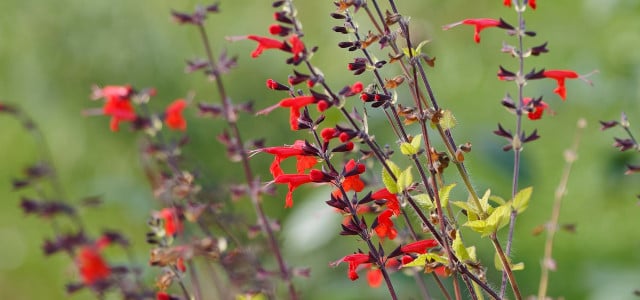
Exotic pineapple sage is a fruity spice for summer dishes and drinks. Here you can learn everything about the use, cultivation and harvesting of the South American herb.
Pineapple sage (Salvia elegans) is a plant of the labiates genus. The plant, which belongs to the sage family, owes its colloquial name to the scent of its leaves, which is reminiscent of pineapple. However, the herb is not related to the tropical fruit.
As with all sage species, both leaves and flowers of pineapple sage can be used for seasoning and cooking. With its bright red flowers, the exotic culinary herb is also a pretty ornamental plant for balconies and gardens. As a late bloomer, it will add color to your garden well into fall.
Contents
Uses: Pineapple sage in summer salads.

Pineapple sage is originally from the highlands of Mexico and Guatemala. Today it enjoys worldwide popularity as an exotic culinary herb.
- Thanks to its sweet note, pineapple sage is ideal for refining desserts, such as fruit salads or cold dishes.
- You can also use the herb to add an exotic touch to fruity salads. The bright red flowers are also a wonderful edible decoration.
- Pineapple sage harmonizes well with other fresh herbs – mint or lemon balm, for example, are ideal partners: Decorate and season fresh summer salads with a combination of pineapple sage and mint.
- Also refine homemade lemonades or iced tea with leaves and flowers of the sage plant.
On cooler days, you can also make tea from the leaves of pineapple sage: To do this, put a few leaves in a tea strainer and steep them in boiling water for about five minutes. Tea made from pineapple sage tastes slightly more tart than the fresh herb.
For any use, the leaves can also be used dried.
Grow pineapple sage
The pretty pineapple sage is an uncomplicated and robust herb. You can cultivate it both in the garden and in a container on the balcony. One thing to keep in mind is that the perennial plant is not hardy and needs to be brought inside during the cold season. With good care, you can enjoy a richly branched shrub up to half a meter in height.
Location
Pineapple sage prefers a sunny to semi-shady and warm location. A wind-protected spot along a house wall or in a sunny corner of your balcony is suitable.
Mild morning and evening sun is good for your sage. However, the herb should not be exposed to midday sun.
Soil
- The exotic herb thrives best in a nutrient and humus rich soil, which may be enriched with a little sand.
- The soil around the root ball should not dry out and should be watered regularly. However, the plant also does not tolerate waterlogging. To prevent this, you can add natural drainage consisting of a generous layer of sand or gravel to the bottom of the planting hole or the bottom of your container.
If you plant your pineapple sage in a pot, be sure to allow water to drain from the pot through the drainage.
During the growing season from spring to late fall, your sage plant will appreciate regular applications of fertilizer. Use homemade compost or organic fertilizer for this purpose.
Overwintering
Pineapple sage is not hardy.
If your pineapple sage is growing in a pot, move it to a cool, unheated spot indoors before the first frost, where the plant will get plenty of daylight. A bright conservatory, greenhouse or even a stairwell are perfect for this.
In winter you can reduce watering and stop fertilizing completely. The plant is now gathering strength until the next shoots.
Pineapple sage growing in the garden must be completely cut back in winter and its roots must be well protected from frost. To do this, lay out a thick layer of brushwood or leaves around the root ball. In colder regions or in very cold winters, the plant cannot always be successfully overwintered. If you are unsure, it is better to plant it in a container.


